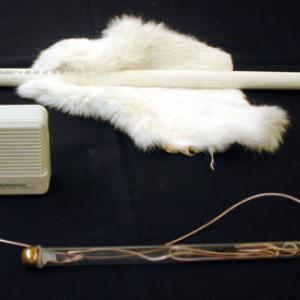College of Liberal Arts & Sciences
5B30.46 - Discharging from a Point
When using the Van de Graaff you will need to use the large neon bulb. Connect the ground of the Van de Graaff to one lead of the neon bulb and the other to either the rod with the point or the rod with the large ball on the end. The rod with point will continuously discharge the Van de Graaff as indicated by the almost continuous glow of the neon bulb. The rod with ball will draw sparks from the Van de Graaff with the neon bulb flashing with each spark. Holding the ball farther away from the Van de Graaff will produce bigger sparks but be cautious as a very large spark may destroy the neon bulb.
NOTE: Do not try this demonstration with the apparatus shown in picture 3 as the Van de Graaff potentials are enough to damage the amplifier.
Charge the rod with the cat's fur. Bring the pointed end of the tester, you should hear a low frequency sound that is made up of electrostatic discharges. Charge the rod again and bring the rounded end of the tester to the rod and only one of two discharges should be heard.
- George Amann, "Crying" Electrostatics", TPT, Vol. 37, Jan. 1999, p. 10.
- Wang Da-yuan, "Lightning Rod", TPT, Vol. 27, # 9, Dec. 1989, p. 686.
- F. James Holitza, "Suppression of Lightning by Chaff Seeding", TPT, Vol. 13, # 8, Nov. 1975, p. 501.
- E. Philip Krider, "Benjamin Franklin and Lightning Rods", Physics Today, Jan. 2006, p. 42.
- Jearl Walker, "5.7, Lightning Rods", The Flying Circus of Physics Ed. 2, p. 221.
- Neil. A. Downie, "Singing Contracts", Ink Sandwiches, Electric Worms and 37 Other experiments for Saturday Science, p. 63.
- 82, "Micro-Bolt", Janice VanCleave's Earth Science for Every Kid, p. 180.
- Joseph Frick, "# 259 - The Action of Points", Physical Technics: Or Practical Instructions for Making Experiments in Physics and the Construction of Physical Apparatus with the Most Limmited Means, p. 282.
Disclaimer: These demonstrations are provided only for illustrative use by persons affiliated with The University of Iowa and only under the direction of a trained instructor or physicist. The University of Iowa is not responsible for demonstrations performed by those using their own equipment or who choose to use this reference material for their own purpose. The demonstrations included here are within the public domain and can be found in materials contained in libraries, bookstores, and through electronic sources. Performing all or any portion of any of these demonstrations, with or without revisions not depicted here entails inherent risks. These risks include, without limitation, bodily injury (and possibly death), including risks to health that may be temporary or permanent and that may exacerbate a pre-existing medical condition; and property loss or damage. Anyone performing any part of these demonstrations, even with revisions, knowingly and voluntarily assumes all risks associated with them.
